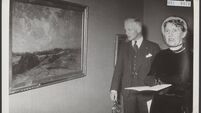Tuft love for duck and duckling
We stuck it for an hour or so but we not only failed to stir a fish, we didn’t even spot a single one rising to a natural fly. It was obviously hopeless so we went back to the hut that we grandiosely call ‘The Lodge’, pulled out two chairs and opened a bottle of wine to drown our sorrows. We were joined by a number of ducks.
The land-owner permits a local gun club to stock mallard on the lake. A consignment had just arrived and, because they had been reared on a game farm, they were quite fearless. In fact they had contributed to the fishing difficulties because whenever they spotted a human figure on the shore they swam over in a tightly-packed flock in the hope of getting fed.
The young ducks waddled up to us as we drank our wine and, when it became obvious that we weren’t going to feed them, they set about foraging for themselves. What they wanted was grass seeds, the nearest thing to the grain they were usually fed on. There was plenty of it but the grass was long and most of the seeds were out of reach. They had to do a lot of stretching and pulling to get a meal.
There is also a pair of mute swans with four cygnets on the lake. The swans and the ducks can be useful to the fishery. They keep at least part of the lake free of ice in cold weather and they help control the density of water plants. The swans are the best at this because they are bigger, operate in deeper water and are exclusively vegetarian. The ducks, when they’re not eating grass seeds, gobble up quite a lot of the invertebrate life that is meant to feed the fish.
The ducks also act as decoys which adds to the variety of the bird life.
Nowadays a decoy duck, as used by people who shoot wildfowl, is made of plastic. But in the 19th century elaborate traps were constructed on lakes and ponds around the country. Wild ducks were lured into the traps by live, tame birds and these traitors were called decoys.
I WAS REMINDED of this when Andrew pointed to a small duck accompanied by an even smaller duckling and asked: “What’s that?” There’s always a pair of binoculars hanging up in the hut and when I got them I discovered that we were looking at two tufted ducks.
The tufted duck is not a particularly rare bird. About 2000 pairs breed in this country and up to 40,000 visit us from colder parts of Europe in the winter. But it is not bred on game farms and these were wild birds that had probably been decoyed in by the mallard.
We quite often see tufted ducks on the lake in winter. But if you were to draw a line connecting Limerick to Dundalk practically all the breeding birds would be north of it. Our lake is quite a bit to the south of the line, so to see a duckling in summer was unusual.
The other unusual thing was that the adult bird was minding the single duckling very carefully as they went about the business of diving for food … but it was a male.
Had there been some recent tragedy that had claimed the female and the rest of the brood? I hope not. Tufted ducks love to eat zebra mussels, which makes them very useful birds.
* dick.warner@examiner.ie













